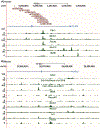Transcription factor GLIS3: Critical roles in thyroid hormone biosynthesis, hypothyroidism, pancreatic beta cells and diabetes
- PMID: 32693112
- PMCID: PMC7606550
- DOI: 10.1016/j.pharmthera.2020.107632
Transcription factor GLIS3: Critical roles in thyroid hormone biosynthesis, hypothyroidism, pancreatic beta cells and diabetes
Abstract
GLI-Similar 3 (GLIS3) is a member of the GLIS subfamily of Krüppel-like zinc finger transcription factors that functions as an activator or repressor of gene expression. Study of GLIS3-deficiency in mice and humans revealed that GLIS3 plays a critical role in the regulation of several biological processes and is implicated in the development of various diseases, including hypothyroidism and diabetes. This was supported by genome-wide association studies that identified significant associations of common variants in GLIS3 with increased risk of these pathologies. To obtain insights into the causal mechanisms underlying these diseases, it is imperative to understand the mechanisms by which this protein regulates the development of these pathologies. Recent studies of genes regulated by GLIS3 led to the identification of a number of target genes and have provided important molecular insights by which GLIS3 controls cellular processes. These studies revealed that GLIS3 is essential for thyroid hormone biosynthesis and identified a critical function for GLIS3 in the generation of pancreatic β cells and insulin gene transcription. These observations raised the possibility that the GLIS3 signaling pathway might provide a potential therapeutic target in the management of diabetes, hypothyroidism, and other diseases. To develop such strategies, it will be critical to understand the upstream signaling pathways that regulate the activity, expression and function of GLIS3. Here, we review the recent progress on the molecular mechanisms by which GLIS3 controls key functions in thyroid follicular and pancreatic β cells and how this causally relates to the development of hypothyroidism and diabetes.
Keywords: Diabetes; Gene transcription; Hypothyroidism; Insulin; Pancreatic β cells; Thyroid hormone biosynthesis.
Published by Elsevier Inc.
Conflict of interest statement
Declaration of Competing Interest The authors declare that there are no conflicts of interest.
Figures




References
Publication types
MeSH terms
Substances
Grants and funding
LinkOut - more resources
Full Text Sources
Medical

